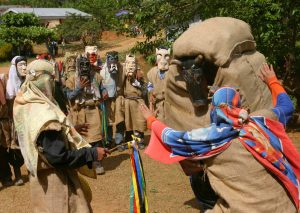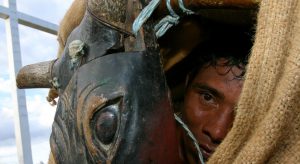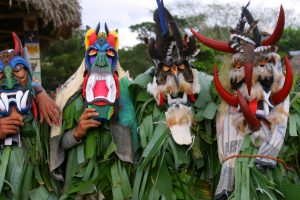“Man, it is something that one carries in the blood. You are born, live and grow with that in your blood, your blood boils with joy at being able to be part of the devils, ”said Edixon Mora, a Boruca indigenous who after his 50 years has accumulated about 30 years that play the traditional Baile de los Diablitos.

The Baile de los Diablitos is a tribute to the warriors who fell during the struggle between the conquerors and the natives, performed by the Boruca indigenous community twice a year. The dance consists of a party in which the men of the community build a balsa wood mask and for three days they dress it when fighting against the bull, a guava wood structure with a bull-shaped mask made of strong wood. cedar.
The bull represents the strong and brave Spaniard who stalked and attacked the indigenous.

The devils are the cunning and skillful indigenous people, who built masks with teeth and horns to scare the Spaniard, but above all to confuse him, because the mask protected the identity of all indigenous people, but especially that of the chief, who could not be distinguished among so many demons.

“You need a lot of physical strength to play,” Mora said, “and you also have to be 50 percent drunk,” he added. During the festivities, as in ancient times, the women are in charge of preparing the food and the girl, a fermented corn drink that helps protect the indigenous. How? because being 50 percent drunk you don’t feel the bumps and falls as much, and you’re relaxed enough not to break any bones.
For Mora, the reason why women do not play devils, more than because of the physical difficulty, is because their obligation is to “preserve the species,” not only by feeding the warrior, but also by being prepared to flee with the youngest in case of danger.
The Baile de los Diablitos is celebrated from December 30 to January 2 in the community of Boruca, and on a weekend between January and February in the community of Rey Curré, both in the southern part of Costa Rica, before arriving to Palmar Norte.
“I tell my children, the day I am bedridden, take me to Boruca because I want to go see the devils,” said Mora, because for him, the mask of the little devil not only protected the indigenous 500 years ago, but that continues to protect you.
Boruca art, including the mask, fabrics, drums, spears and others, has become a source of life for the indigenous people, providing economic stability. Around 90 percent of Boruca’s inhabitants, men and women, live today from the production of handicrafts that are sold in all corners of the country.

Mora is one of those artisans who pride themselves on preserving and harnessing the richness of their culture. In his house in Rey Curré, 300 m east of the communal hall, he has his workshop and sale of Boruca art, called Cújsrót, an indigenous name for the woodpecker Campephilus guatemalensis (Pale-billed Woodpecker in English) who according to Mora is the best craftsman who there is.
“The mask keeps giving me life,” added Mora.
The Cújsrót Workshop specializes in the creation of the traditional Boruca mask, centered on the face of the little devil with its horns and quotes. However, Boruca art has evolved with the participation of younger artisans who have brought inspiration from nature to their designs, incorporating figures of animals and plants in the designs of the little devils.

—
A previous version of this piece was published in Nature Landings, the in-flight magazine of Nature Air.







